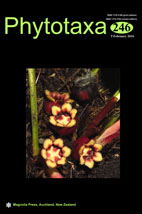Abstract
Two new diatom species, Fragilaria neotropica sp. nov. and F. spectra sp. nov., from six reservoirs with different trophic status in the Alto Tietê River Basin, São Paulo, Brazil, are described. Descriptions are based on light (LM) and scanning electron microscopy (SEM) data revealing that both taxa have distinctive features that separate them from each other and from other taxa currently in Fragilaria. Fragilaria neotropica has high stria density, broader (sometimes deformed) central area, and capitate (often deflected) apices. This species was found in high abundance as part of the phytoplankton, periphyton and surface sediments in mesotrophic reservoirs. On the other hand, F. spectra has indistinct striae (not clearly seen in LM), wide sternum, two rimoportulae per valve and lacks spines. This taxon was abundant in the phytoplankton and periphyton of oligotrophic to mesotrophic reservoirs. A discussion of morphological and ecological aspects in the light of available literature is presented, as well as a morphological comparison based on LM and SEM analysis of the original material of F. tenera.

